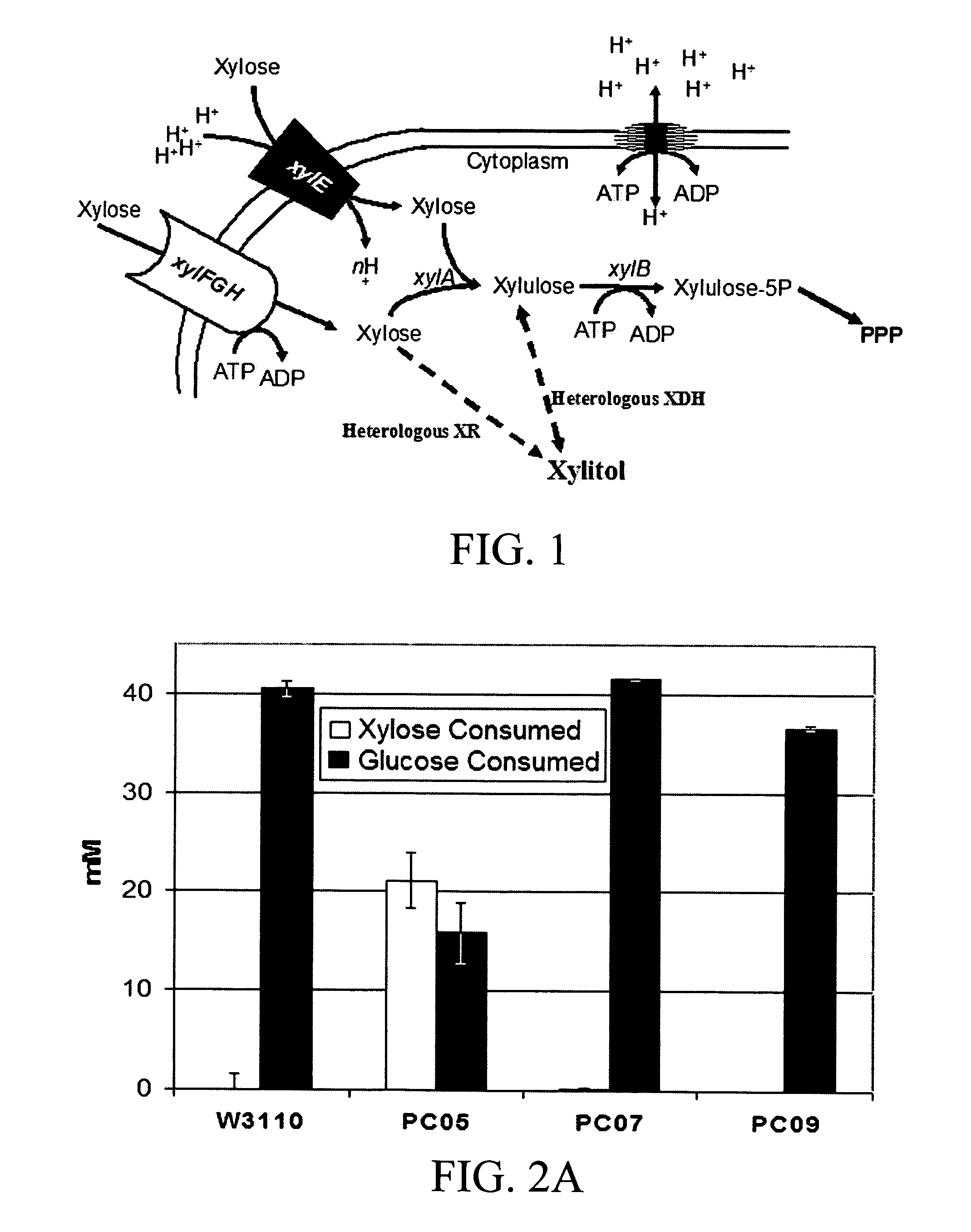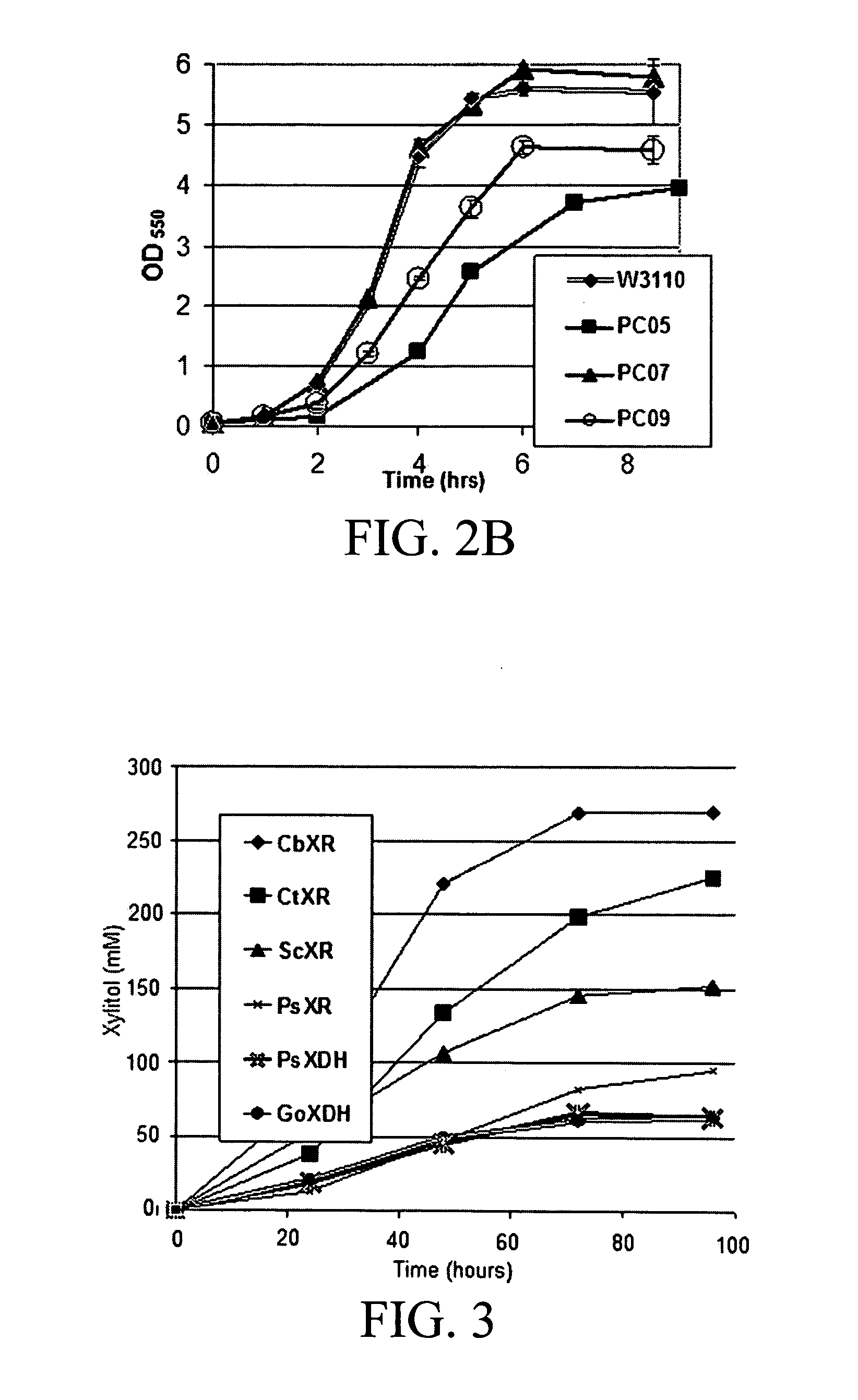Materials and methods for the efficient production of xylitol
- Summary
- Abstract
- Description
- Claims
- Application Information
AI Technical Summary
Benefits of technology
Problems solved by technology
Method used
Image
Examples
example 1
AND METHODS
[0060]E. coli W3110 (ATCC 27325) and derivative strains were maintained on plates containing either Luria-Bertani (LB) medium or minimal medium containing mineral salts (per liter: 3.5 g KH2PO4; 5.0 g K2HPO4; 3.5 g (NH4)2HPO4, 0.25 g MgSO4. 7 H2O, 15 mg CaCl2. 2 H2O, 0.5 mg thiamine, and 1 ml of trace metal stock), glucose (2%), and 1.5% agar. The trace metal stock was prepared as described by Causey T B et al., “Engineering the metabolism of Escherichia coli W3110 for the conversion of sugar to redox-neutral and oxidized products: Homoacetate production,”Proceedings of the National Academy of Sciences of the United States of America, 100:825-832 (2003). 4-Morpholinopropanesulfonic acid (MOPS) was added to liquid media for pH control (50 mM, pH 7.0), but was not included in medium used for 10-L fermentations. Antibiotics were included as appropriate (kanamycin, 50 mg L−1; ampicillin, 50 mg L−1; apramycin, 50 mg L−1 and tetracycline, 12.5 mg L−1) and β-D-thiogalactopyranos...
example 2
IZATION OF STRAINS
[0074] Table 1 lists the strains and plasmids used in accordance with the Examples of the subject invention. Our initial studies involved expression of XDH cloned from Gluconobacter oxydans (Sugiyama et al. 2003) in E. coli W3110 and its derivative PC07, containing a xylB (xylulokinase gene) deletion. Low concentrations of xylitol were produced in LB broth containing xylose alone, xylose plus sorbitol, and xylose plus glucose. Neither strain produced xylitol in the absence of XDH expression. For further studies we developed strain PC05, constitutive in xylose metabolism due to the replacement of the native crp gene with a mutant gene (corresponding to three amino acid substitutions) encoding a cAMP-independent CRP variant (denoted “CRP*” or “CRP-in”) (Eppler and Boos 1999). The CRP* phenotype should promote xylose uptake in the presence of glucose by activating the native xylose transporters and / or by activating other CRP-controlled promiscuous transporters capable...
example 3
L ASSESSMENT OF BIOTRANSFORMED MICROBES
[0078] The in vivo activity of several different XR and XDH enzymes in E. coli were expressed and compared in order to identify a suitable system to use for further engineering of xylitol production by microorganisms of the invention. Table 2 lists the enzymes tested and their corresponding cofactor preferences. Xylose reductase from Candida boidinii (CbXR) was identified as having the highest activity of the enzymes tested under the expression system, which was measured as xylitol produced in strain PC09 from mixtures of glucose and xylose in shake-flask cultures. This enzyme was therefore chosen for further xylitol production studies using controlled fermentation and non-growing (“resting”) cells.
TABLE 2Xylose reductase (XR) and xylitoldehydrogenase (XDH) enzymes used.EnzymeName used hereinCofactor usageReductases: Xylose → XylitolCandida boidinii XYL1CbXRNADPHSaccharomyces cerevisiae GRE3ScXRNADPHCandida tenuis XYL1CtXRNADPH > NADHPichia s...
PUM
 Login to View More
Login to View More Abstract
Description
Claims
Application Information
 Login to View More
Login to View More - R&D
- Intellectual Property
- Life Sciences
- Materials
- Tech Scout
- Unparalleled Data Quality
- Higher Quality Content
- 60% Fewer Hallucinations
Browse by: Latest US Patents, China's latest patents, Technical Efficacy Thesaurus, Application Domain, Technology Topic, Popular Technical Reports.
© 2025 PatSnap. All rights reserved.Legal|Privacy policy|Modern Slavery Act Transparency Statement|Sitemap|About US| Contact US: help@patsnap.com



